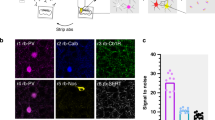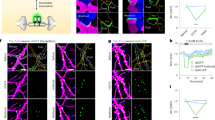Abstract
Labeling fixed brain tissue with fluorescent synaptic and cellular markers can help assess circuit connectivity. Despite the diffraction-limited resolution of light microscopy there are several approaches to identify synaptic contacts onto a cell-of-interest. Understanding which image quantification methods can be applied to estimate cellular and synaptic connectivity at the light microscope level is beneficial to answer a range of questions, from mapping appositions between cellular structures or synaptic proteins to assessing synaptic contact density onto a cell-of-interest. This chapter provides the reader with details of the image analysis methods that can be applied to quantify in situ connectivity patterns at the level of cellular contacts and synaptic appositions.
Correspondence may be addressed to either author.
Access this chapter
Tax calculation will be finalised at checkout
Purchases are for personal use only
Similar content being viewed by others
References
Grimes WN, Hoon M, Briggman KL, Wong RO, Rieke F (2014) Cross-synaptic synchrony and transmission of signal and noise across the mouse retina. Elife 3:e03892
Okawa H, Della Santina L, Schwartz GW, Rieke F, Wong RO (2014) Interplay of cell-autonomous and nonautonomous mechanisms tailors synaptic connectivity of converging axons in vivo. Neuron 82:125–137
Morgan JL, Soto F, Wong RO, Kerschensteiner D (2011) Development of cell type-specific connectivity patterns of converging excitatory axons in the retina. Neuron 71:1014–1021
Morgan JL, Schubert T, Wong RO (2008) Developmental patterning of glutamatergic synapses onto retinal ganglion cells. Neural Dev 3:8
Bleckert A, Parker ED, Kang Y, Pancaroglu R, Soto F et al (2013) Spatial relationships between GABAergic and glutamatergic synapses on the dendrites of distinct types of mouse retinal ganglion cells across development. PLoS One 8:e69612
Kerschensteiner D, Morgan JL, Parker ED, Lewis RM, Wong RO (2009) Neurotransmission selectively regulates synapse formation in parallel circuits in vivo. Nature 460:1016–1020
Schubert T, Hoon M, Euler T, Lukasiewicz PD, Wong RO (2013) Developmental regulation and activity-dependent maintenance of GABAergic presynaptic inhibition onto rod bipolar cell axonal terminals. Neuron 78:124–137
Newkirk GS, Hoon M, Wong RO, Detwiler PB (2013) Inhibitory inputs tune the light response properties of dopaminergic amacrine cells in mouse retina. J Neurophysiol 110:536–552
Dunn FA, Della Santina L, Parker ED, Wong RO (2013) Sensory experience shapes the development of the visual system’s first synapse. Neuron 80:1159–1166
Soto F, Bleckert A, Lewis R, Kang Y, Kerschensteiner D et al (2011) Coordinated increase in inhibitory and excitatory synapses onto retinal ganglion cells during development. Neural Dev 6:31
Morgan JL, Wong RO (2008) Ballistic labeling with fluorescent dyes and indicators. Curr Protoc Neurosci Chapter 2:Unit 2.11
Swartz M, Eberhart J, Mastick GS, Krull CE (2001) Sparking new frontiers: using in vivo electroporation for genetic manipulations. Dev Biol 233:13–21
Zucker RM, Rigby P, Clements I, Salmon W, Chua M (2007) Reliability of confocal microscopy spectral imaging systems: use of multispectral beads. Cytometry A 71:174–189
Scriven DR, Lynch RM, Moore ED (2008) Image acquisition for colocalization using optical microscopy. Am J Physiol Cell Physiol 294:C1119–1122
Schindelin J, Arganda-Carreras I, Frise E, Kaynig V, Longair M et al (2012) Fiji: an open-source platform for biological-image analysis. Nat Methods 9:676–682
Wu Y, Eghbali M, Ou J, Lu R, Toro L et al (2010) Quantitative determination of spatial protein-protein correlations in fluorescence confocal microscopy. Biophys J 98:493–504
Comeau JW, Kolin DL, Wiseman PW (2008) Accurate measurements of protein interactions in cells via improved spatial image cross-correlation spectroscopy. Mol Biosyst 4:672–685
Hoon M, Bauer G, Fritschy JM, Moser T, Falkenburger BH et al (2009) Neuroligin 2 controls the maturation of GABAergic synapses and information processing in the retina. J Neurosci 29:8039–8050
Mokin M, Keifer J (2006) Quantitative analysis of immunofluorescent punctate staining of synaptically localized proteins using confocal microscopy and stereology. J Neurosci Methods 157:218–224
Mokin M, Keifer J (2004) Targeting of GLUR4-containing AMPA receptors to synaptic sites during in vitro classical conditioning. Neuroscience 128:219–228
Fish KN, Sweet RA, Deo AJ, Lewis DA (2008) An automated segmentation methodology for quantifying immunoreactive puncta number and fluorescence intensity in tissue sections. Brain Res 1240:62–72
Ippolito DM, Eroglu C (2010) Quantifying synapses: an immunocytochemistry-based assay to quantify synapse number. J Vis Exp pii:2270
Dunn KW, Kamocka MM, McDonald JH (2011) A practical guide to evaluating colocalization in biological microscopy. Am J Physiol Cell Physiol 300:C723–742
Meyer F (1992) Color image segmentation, in Proceedings of the IEE International Conference on Image Processing and Its Applications, Maastricht, the Netherlands, IEE, London, UK, pp. 303–306
Vincent L, Soille P (1991) Watersheds in digital spaces: an efficient algorithm based on immersion simulations. IEEE Trans Pattern Anal Mach Intell 13:583–598
Busse B, Smith S (2013) Automated analysis of a diverse synapse population. PLoS Comput Biol 9:e1002976
John Wiley & Sons, Inc is the publisher which has multiple locations worldwide so cannot specify a single location with certainty but if one must absolutely be used use New York
Acknowledgments
The dot-finding routine was developed by Josh Morgan and further refined by the collaborative efforts of past and present Rachel Wong Lab members. Credit for the dot-finding routine goes to the concerted efforts of Josh Morgan, Daniel Kerschensteiner, Adam Bleckert, and Haruhisa Okawa. Daniel Kerschensteiner, Florentina Soto, Josh Morgan, and Adam Bleckert together developed the correlation analysis. We are grateful to Rachel Wong and Adam Bleckert for critical feedback and suggestions during preparation of this chapter. This work is supported by NIH grants (EY10699, EY17101, and EY14358 to R. Wong and a Vision Core grant EY01730); a Human Frontier Science Program grant (RGP0035 to L. Lagnado, F. Schmitz, and R. Wong); a Human Frontier Science Program Long term fellowship (R. Sinha); and a Knights Templar Eye Foundation career starter grant (M. Hoon). The immunolabeling for Ribeye and GABAA receptors shown in the Figures has been possible due to antibodies generously provided by Frank Schmitz and Jean-Marc Fritschy.
Author information
Authors and Affiliations
Corresponding authors
Editor information
Editors and Affiliations
Rights and permissions
Copyright information
© 2017 Springer Science+Business Media LLC
About this protocol
Cite this protocol
Hoon, M., Sinha, R., Okawa, H. (2017). Using Fluorescent Markers to Estimate Synaptic Connectivity In Situ. In: Poulopoulos, A. (eds) Synapse Development. Methods in Molecular Biology, vol 1538. Humana Press, New York, NY. https://doi.org/10.1007/978-1-4939-6688-2_20
Download citation
DOI: https://doi.org/10.1007/978-1-4939-6688-2_20
Published:
Publisher Name: Humana Press, New York, NY
Print ISBN: 978-1-4939-6686-8
Online ISBN: 978-1-4939-6688-2
eBook Packages: Springer Protocols




